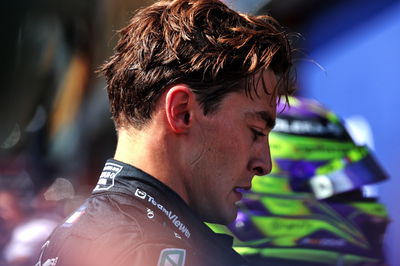Explained: The reasons George Russell’s DQ’d car was underweight
Did George Russell's one-stop strategy lead to his disqualification at the Belgian Grand Prix?

George Russell’s one-stop strategy at the F1 Belgian Grand Prix was a likely contributor to his car being underweight, ultimately leading to his disqualification.
While Russell won the race on track at Spa-Francorchamps, he was excluded from the final results following the FIA’s post-race checks.
This handed Lewis Hamilton his second F1 victory of the year ahead of Oscar Piastri and Charles Leclerc.
Russell’s car was only 1.5kg under the weight limit, but with the rules clear-cut, he was disqualified by the stewards.
Sky Sports’ Craig Slater has suggested, following a conversation with Mercedes, that Russell’s inspired one-stop strategy could have led to his disqualification.
Slater explained: “The reasons? I’ve had some guidance from within the Mercedes team about why they were underweight. It was to do Russell’s single-stop strategy.
“The teams know exactly how much weight they will shed when tyres wear down.
“Russell would have been expected to make two stops today. It was his own idea, in conjunction with his pit wall, that later switched it to a single stop.
“It was the extra tyre wear that they’ve lost, perhaps several hundred grams per tyre, with the fact that they didn’t make a second stop and put on a fresh set, which has brought them in underweight.
“Combined with, the team think, changing the car set-up pretty radically between Friday (when they abandoned some of the upgraded parts and reverted to earlier parts for qualifying and the race).”
Another factor could have been the fact there was no conventional in-lap at Spa.
Due to the long nature of the Spa circuit, drivers turn right back into the pit lane at the end of the race, meaning they can’t pick up rubber.
“Lewis Hamilton’s car was compliant but Russell’s was not,” he added. “There is also a feeling that, on the way in after the race, Russell did not pick up the usual stones and bits of rubber debris.
“It is remarkable but all of these things are factored in when teams go racing. They know exactly how much their car needs to weigh, and they factor in this kind of thing, to make sure they are on the limit but not above it. Because every kilogram is maybe a tenth of a second.
“So breaching the rules would be seen as a competitive advantage. The fuel meant that the car was not underweight during the grand prix, in actual terms. But the rule about measuring the dry weight is there for a specific reason - it’s about using fuel as ballast, which is not permitted.”












